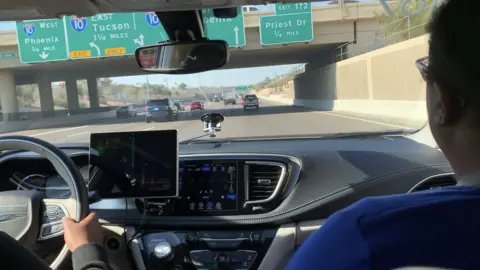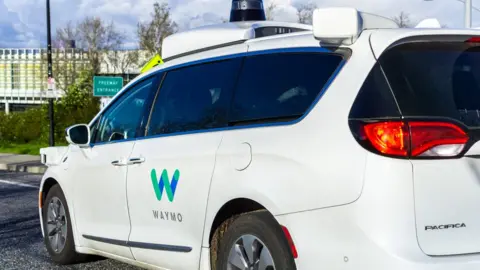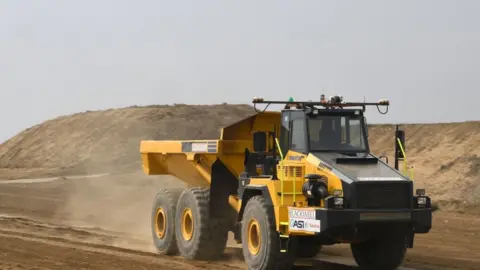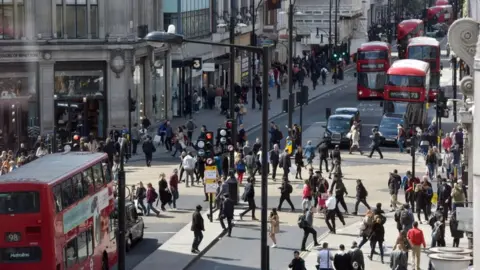Robots on the road - how close is our driverless future?

 BBC
BBCIt was on the motorway near Phoenix, Arizona, that I realised fully driverless cars might be quite a distant dream. And that was because our Google Waymo robo-taxi seemed incapable of leaving that motorway.
We were in Arizona to record a radio documentary for the BBC World Service about the progress towards creating autonomous vehicles that would make our roads safer and replace human drivers with robots.
Google leads this race at the moment and for the past six months has been offering a robo-taxi service, Waymo One, to a select few early adopters in and around the Phoenix suburb of Chandler.
Our first ride with Waymo took us through the quiet suburban streets, where traffic is sparse and drivers well mannered.
Here, the minivan, fitted out with a battery of sensors and high-definition cameras, performed very impressively, handling slightly tricky left turns, spotting other road users and slowing down as it passed a school.
While a Google engineer sat behind the wheel, she never intervened and soon we relaxed and forgot that we were effectively being driven by a robot.
Then, we hitched a ride with Shawn Metz, one of a few hundred locals selected as customers of Waymo One.
He told us he and his wife used the service for their weekly shop, nights out and in places with limited parking.
"We're hoping to go from a two-vehicle to a one-vehicle household eventually and optimistic this technology might get us there," he said.
But as we headed along the motorway on the 20-minute ride to his office, things began to go wrong.
As we approached our exit, there was a solid line of traffic to our right.
An assertive human driver would probably have squeezed over and made it to the exit lane - but the robot, which cannot exceed the speed limit, was more cautious.
 Getty Images
Getty ImagesThe car missed that exit and the next one before finally leaving the motorway.
And when we were back on the suburban streets, it appeared to freeze at a junction where it needed to turn left across traffic - after a while, the engineer behind the wheel had to take over and complete the turn.
Mr Metz told us that in his experience this was a very rare occurrence.
Slow progress
Nevertheless, it served as an illustration that the Waymo autonomous driving technology, widely thought to be ahead of its competitors, still needs to be refined.
It is understandable, however, that the system is programmed to be ultra-cautious.
After all, just a few miles away, another self-driving car killed a pedestrian in an accident in March 2018, which shook confidence in autonomous technology.
The car belonged to Uber, one of Waymo's big rivals, and it ploughed into a woman pushing a bike across a road near Arizona State University.
An investigation found that the safety driver had been watching a video on her phone at the moment of impact.
The ideal road and weather conditions coupled with welcoming local officials have made the Phoenix area one of the world's leading locations for testing autonomous vehicles.
 PA
PAAt first, there was little opposition but local journalist Ryan Randazzo said the accident had shaken public confidence.
"To have an accident that was the exact kind of thing that these cars were supposed to be able to prevent really rattled people's nerves," he said.
"And I certainly hear a lot more feedback from people in this area who are not comfortable with these tests going on in their community."
Clem Wright, product manager at Waymo, admitted the Uber accident had brought home how high the stakes were in the race to build self-driving cars but stressed his company was being meticulous in its testing.
"We have 10 million miles on public roads, gathering these different scenarios," he said.
"And then we also use simulation where we say, 'Hey, here's a tricky situation. What if this car is coming 10 miles per hour faster? What if a bicycle is swerving into us?'"
Pedestrian power
Nevertheless, with huge sums being invested by both technology companies such as Google and traditional car-makers, there are some brave predictions of when the robots will be able to take to the road without a human safety driver.
Ken Washington, Ford's chief technology officer, told us his company's extensive autonomous driving programme would deliver results in a couple of years.
He said: "Between now and 2021, we're going to apply that learning in a way that allows us to eventually take that safety driver out of the system on selected routes."
In the UK, the Chancellor, Philip Hammond, has also promised that "genuine driverless cars" will be on the roads by 2021.
Waymo has already received permission to operate without a driver in a limited area near Google's Mountain View headquarters, in California.
But any experiments with fully autonomous vehicles are likely to take place under strictly controlled conditions for years to come.

Myra Blanco, a researcher at the Virginia Tech Transport Institute, in the US, said we would probably see driverless cars in geo-fenced areas in two to five years but she was far more sceptical about full automation.
"That means going from the mountains, rural roadways, all the way to the city - that is going to take a little bit longer, probably potentially a couple of decades away," she said.
Even then, there will be real problems in mixing the robots, the human drivers and pedestrians on the same streets.
Far from the orderly roads of Arizona, I stood with the transport writer Christian Wolmar at the hectic crossroads outside Holborn Tube station, in central London.
He pointed out that pedestrians would have no hesitation in stepping out in front of driverless cars, knowing they were programmed to stop, and the result would be gridlock.
"Once you set the rule that driverless cars have to effectively kowtow to any pedestrian in the street, and pedestrians begin to learn that, then the whole balance of power in our streets will change," he said.
"The concept just doesn't survive the idea of mixed use streets."
The robots are coming to our roads but they are still nervous new drivers with a lot to learn.
For all the warnings that millions of driving jobs could be automated out of existence, it looks as though humans will stay behind the wheel for years to come.
The radio documentary Robots on the Road will be broadcast today at 13:32 on the World Service.
